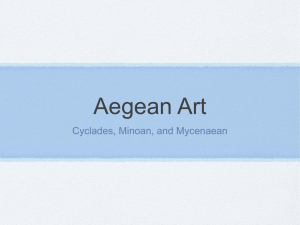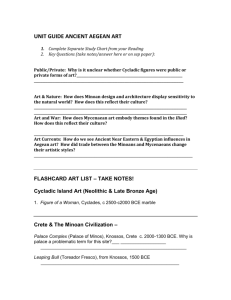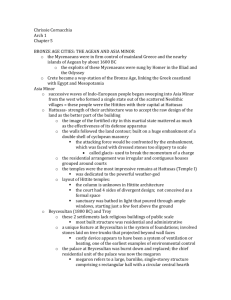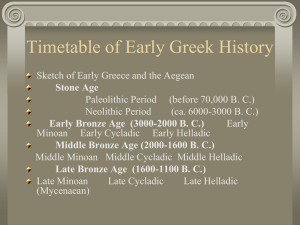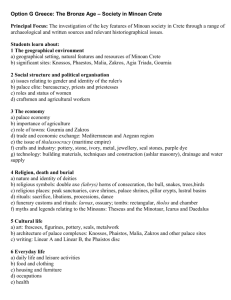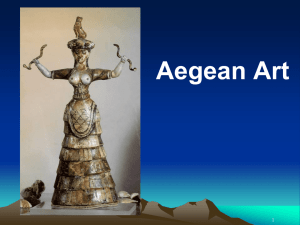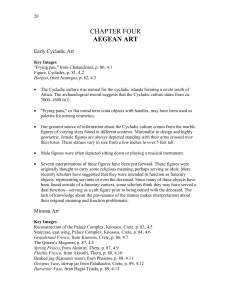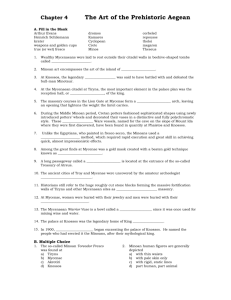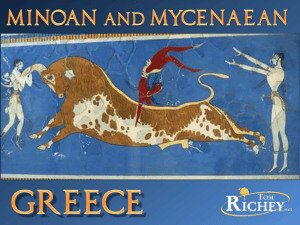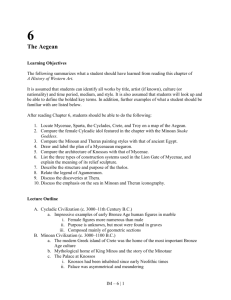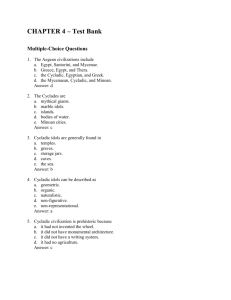ART201 ART HISTORY 1
advertisement
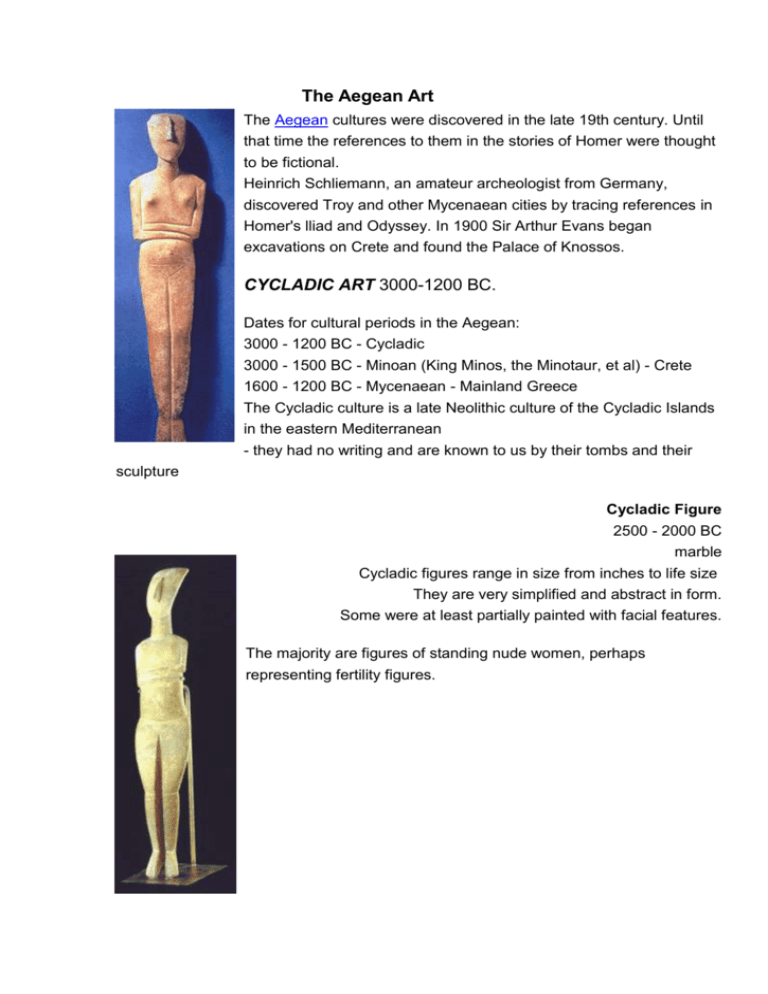
The Aegean Art The Aegean cultures were discovered in the late 19th century. Until that time the references to them in the stories of Homer were thought to be fictional. Heinrich Schliemann, an amateur archeologist from Germany, discovered Troy and other Mycenaean cities by tracing references in Homer's lliad and Odyssey. In 1900 Sir Arthur Evans began excavations on Crete and found the Palace of Knossos. CYCLADIC ART 3000-1200 BC. Dates for cultural periods in the Aegean: 3000 - 1200 BC - Cycladic 3000 - 1500 BC - Minoan (King Minos, the Minotaur, et al) - Crete 1600 - 1200 BC - Mycenaean - Mainland Greece The Cycladic culture is a late Neolithic culture of the Cycladic Islands in the eastern Mediterranean - they had no writing and are known to us by their tombs and their sculpture Cycladic Figure 2500 - 2000 BC marble Cycladic figures range in size from inches to life size They are very simplified and abstract in form. Some were at least partially painted with facial features. The majority are figures of standing nude women, perhaps representing fertility figures. Lyre Player c. 2700 - 2500 BC marble, 9" h. Male figures are far less common than female figures. They are typically represented as musicians. Musicians are always male and have, with few exceptions, always been found in burial sites -Notice how the male figure is made up of open forms as opposed to the closed form of the female figure. MINOAN ART 3000-1500 B.C. (Middle and Late Minoan) Palace at Knossos Reconstruction Drawings Referred to as the Palace of Minos Initially excavated by Sir Arthur Evans beginning in 1890. Evans believed he had found the labyrinth of Minos - called civilization "Minoan" The palace is partially restored It is a large open complex - labyrinthine 100's of rooms - up to 3 stories tall - with little apparent order - But, it had a well designed sanitary drainage system making it a very livable home Around 1700 BC the palace was destroyed - possibly as the result of volcanic action and/or related earthquakes - it was rebuilt then again destroyed in 1400 BC - It has no fortifications - Minoans were a sea power and had little need for the citadels common in Mesopotamia The Egyptians knew the Minoans as the "Sea People" (Ramsses II (the Great) gives a major history of his battles with the Sea People) The complex was very open and airy - many skylights with light wells to illuminate the interior (on the right) - it was not only a residential palace - also administrative center - shipping and trading were foundation of their economy "Queens Megaron" (above, left) The Queen's Megaron nicely shows the light, open nature of the interior rooms of the palace at Knossos. Also, like the King's Megaron, below, it is decorated with graceful, natural motifs - here dolphins and fish swimming in the sea. Images such as these make it easy to imagine that the Minoans lived a life in harmony with nature and the sea that surrounded them. Kings Megaron - Megaron means great room - Megarons are audience halls Here in the King's Megaron at Knossos the walls are painted with organic forms and subjects that show a harmonious relationship with the natural world. Sea forms - sea weed in current.... also, graceful, gryphon-like animals FRESCOS (In fresco paintings the paint is applied to wet plaster and becomes part of the wall as the plaster dries. The mineral pigments are chemically bound in the lime of the plaster.) Minoan painting is light and airy like the atmosphere of the palace and the Cretan countryside and the sea It is fluid and graceful - dance like Toreador Fresco 32" high Ritual bull jumping - held in the courtyard - may have had religious purpose Snake Goddess c. 1600 BC, faience, 13" h - FAIENCE - brightly glazed earthenware pottery - the glaze is made from melted quartz layered over the terracotta - Figure may be deity - or a priestess - She holds snakes (male fertility? ) and a cat sits on her head - costume is a typical Minoan flounced dress with an open bodice The Snake Goddess was originally identified by Evans as a "votary". When found it was missing its head, most of its hat, the right arm, the lower part of the snake held in the right hand, and large segments of the skirt. The partial reconstruction in the photographs below was eventually completed with the addition of the left forearm, a hand holding a purely conjectural snake, and the head. - Beaked Jug c. 1800 BC, ceramic MYCENAEAN ART 1600 – 1200 BC Acropolis of Mycenae c. 1300 BC Octopus Vase c. 1, 500 BC, ceramic Mycenae and Tiryns were two major political and economic centers on the mainland of Greece, capitals of the warrior kings who raided the eastern Mediterranean and perhaps led the expedition that lay siege to the city of Troy. Mycenaean civilization mysteriously disappeared around 1200 BC. It is also believed that the Mycenaeans were partially or wholly responsible for the end of the Minoan culture with whom they had many ties. This theory is supported by a switch on the island of Crete from the Cretan Linear A Script to the Mycenaean Linear B style script and by changes in ceramics styles and decoration. The citadel of Mycenae is an Acropolis - a citadel on raised area - acro "high" - Polis "city" The Lion Gate - Entry in to the Acropolis of Mycenae is popularly considered to be the capital of King Agamemnon who is said to have led the expedition that laid siege to the city of Troy according to Homer. The Lion Gate is an excellent example of post and lintel construction combined with a corbeled arch the triangular arch shape that the lions stand within. The Greek mainland is very different from Crete. Palaces are large citadels made of piled up stones - called Cyclopean Architecture by later Greeks - as opposed to the openness of the palace at Knossos The term cyclopean architectures was created by later Greeks who thought only Cyclops (one eyed giants) could build such structures. The nearby citadel of Tiryns is referred to by Homer as "Tiryns of the Great Walls" and is the mythological birthplace of Hercules. MYCENAEAN MEGARONS Megaron at Pylos reconstruction Megaron Floor Plan The Megaron is a characteristic form of Mycenaean palace found at many sites, including Troy. They are very symmetrical and its basic form is a forerunner of later Greek temple forms. They are square with a central fire pit framed by four columns. THOLOS TOMBS Treasury of Atreus, view of the dromos and entry The acropolis compound of Mycenae included simple shaft graves and more sophisticated tholos tombs. Tholos tombs are conical chambers resembling the classic beehives ("beehive tombs"). The burial chamber is subterranean. There are 9 at Mycenae. This particular one was misnamed the "treasury" by Schliemann in 1876. He was very much into the romance of Homer's literature and his role in excavating the historic sites tied to the literature. Atreus was the Homeric father of Agamemnon and Menelaus the two major kings on the Greek side in the Trojan War. Menelaus was the rightful husband of Helen. Interior View of the Treasury of Atreus Cut-away View of a Tholos Tomb Entry to a tholos tomb was through a long passage way - the dromos. The main chamber the tholos is about 43' high. The stonework of the tholos is very much influenced by Egyptian masonry techniques. In the earlier shaft graves the face of the deceased was covered with a gold death mask. These burial practices are similar to Egyptian burial practices and it's thought that Mycenaean mercenaries may have been employed by the Egyptians in their fight to repel the Hyskos during the Second Intermediate Period(1750-1550 BC). While there they would have learned much from the Egyptians and developed a great taste for gold. MYCENAEAN GOLD WORK Gold Mask c. 1600 - 1500 BCE, gold, 12" h. This gold death mask was found in one of the shaft graves by Heinrich Schliemann who dubbed it the "Mask of Agamemnon". While it was probably not the grave of Agememnon it would have been the burial of a king or equally important man. Vaphio Cup, c. 1500 BCE, gold, 3.5" h. The style of figures is very much based upon Minoan figures and some scholars suggest that it may have been made on Crete. The story depicted is of a bull are being trapped and snared using a cow as bait. This bull is much more aggressive than the playful, elegant bull of the Toreador Fresco . Sources: Alan Petersen’s Art History 201 & Christopher L. C. E. Witcombe’s Women in the Aegean
